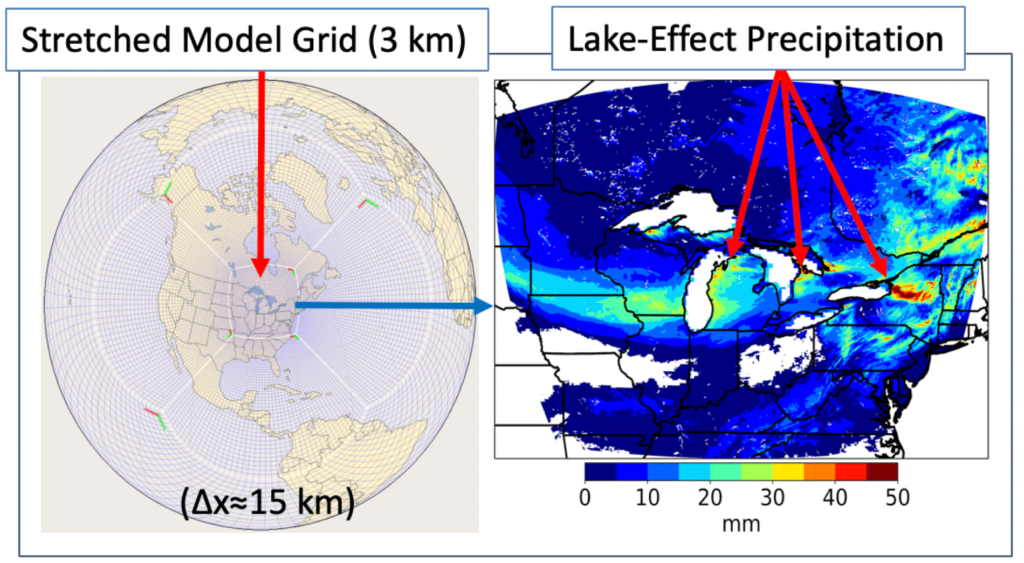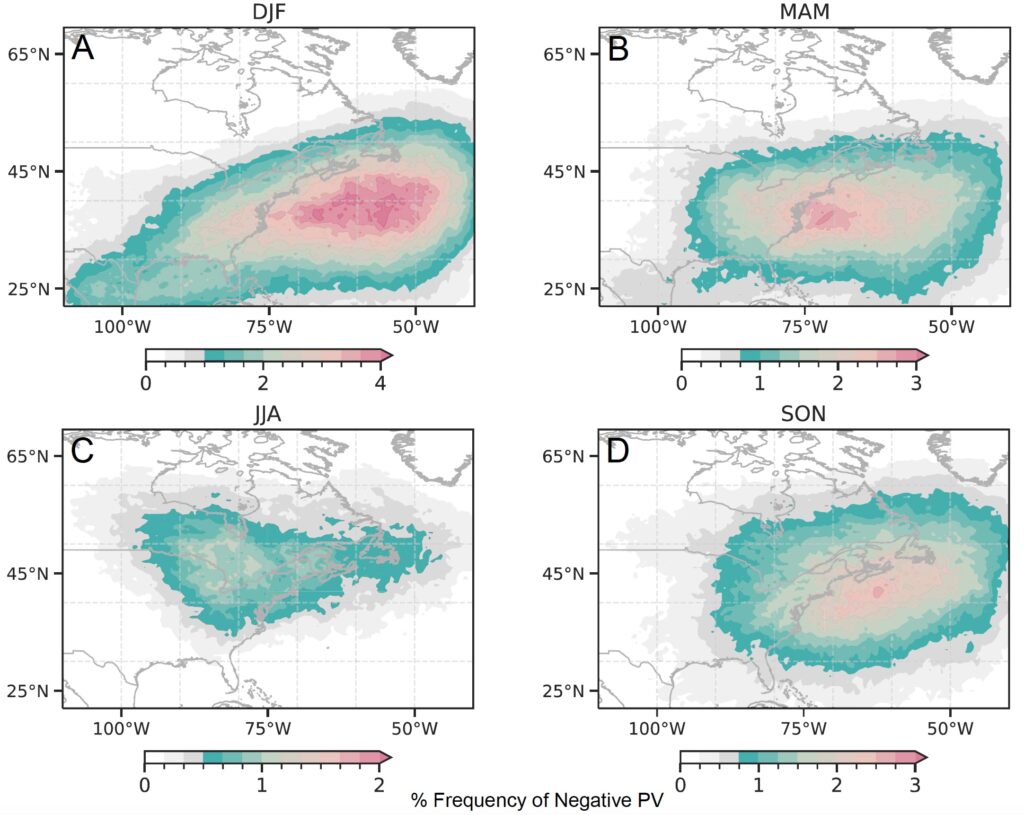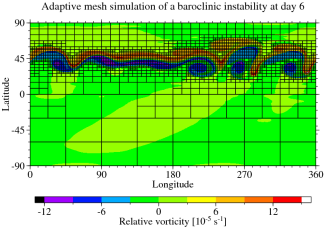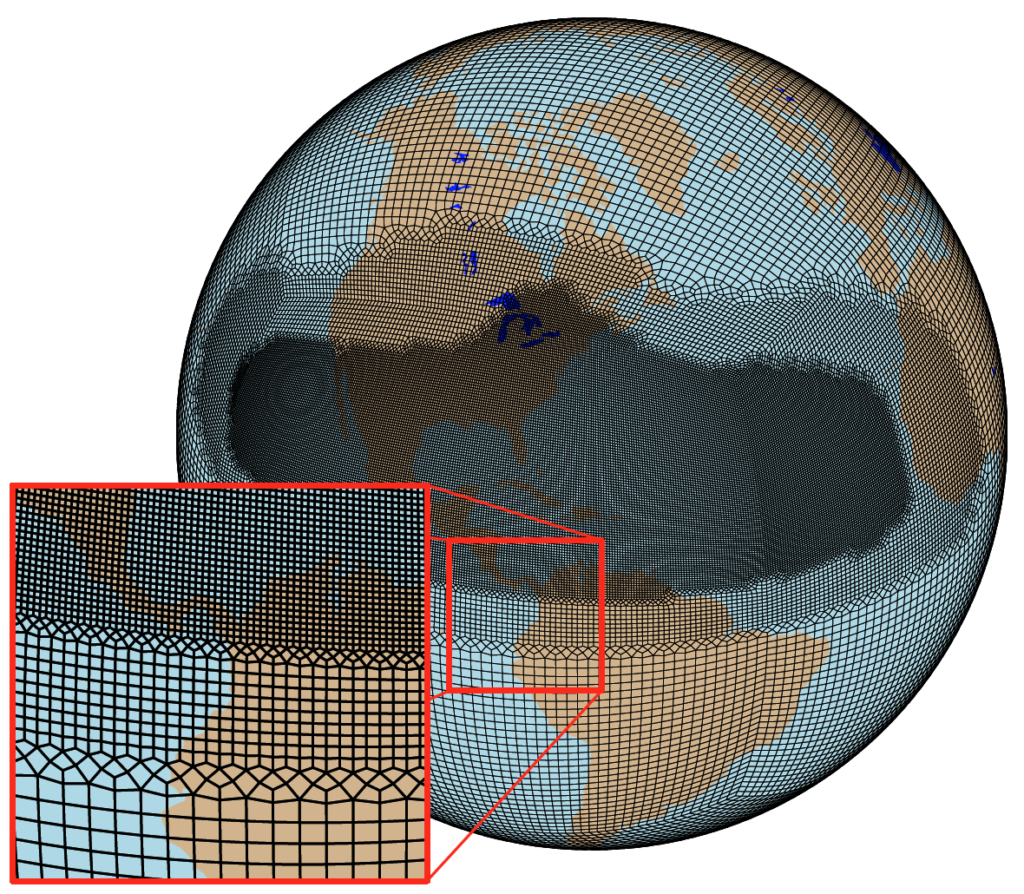Overview of our Research
The research projects in our group are focused on the overarching themes of atmospheric modeling and dynamics. Over the last few years (since 2018) we also started exploring machine learning concepts for the atmospheric sciences and a coupled lake-atmosphere weather-modeling project that focuses on the Great Lakes region (2019). Our group is highly interdisciplinary with diverse interests in atmospheric science, applied mathematics, computational science / scientific computing and data science.
In particular, we (1) explore new numerical methods and emerging non-hydrostatic and deep-atmosphere modeling approaches for the dynamical cores of atmospheric General Circulation Models (GCMs), (2) advance weather and climate models at convection-permitting scales, (3) analyze and compare existing dynamical cores (especially their behavior at the subgrid-scale), (4) develop simpler atmospheric models and test cases for dynamical cores that get utilized in community-wide model intercomparison projects, (5) analyze the interactions between Mesoscale Convective Systems (MCSs) and the global circulation in weather models, (6) investigate stratospheric dynamics with a focus on the Quasi-Biennial Osciillation (QBO), the water vapor tape recorder, the Brewer-Dobson circulation and Sudden Stratospheric Warmings (SSWs), (7) investigate the impact of volcanic eruption on the general circulation, (8) provide insight into physics-dynamics coupling issues in models, (9) couple lake models for the Great Lakes to NOAA’s Unified Forecast System (UFS, and (10) develop the future-generation kilometer-scale modeling capability for NCAR’s Community Earth System Model (CESM) in collaboration with NCAR, Texas A&M University, and Sandia National Laboratories. In the past, we also designed cyber-infrastructure tools for the climate sciences, developed Adaptive Mesh Refinement and variable-resolution techniques for GCMs, and advanced tropical cyclone research. All of our research projects utilize parallel and high-performance computing architectures.
NSF StormSPEED: The ‘Storm-resolving SPEctral Element Dycore’ for CESM3
NSF StormSPEED webpage: https://sites.google.com/umich.edu/nsf-stormspeed
This NSF-funded project is a collaboration between our UM team, NCAR, and Texas A&M University (TAMU). In addition, we collaborate with Sandia National Laboratories and Colorado State University (CSU). NSF StromSPEED integrates the Department of Energy’s (DoE) non-hydrostatic Spectral Element (SE-NH) dynamical core into the CESM Community Atmosphere Model (CAM) to enable kilometer-scale, cloud-permitting, coupled climate simulations within the NCAR’s CESM framework. Both the Fortran version and DoE’s C++/Kokkos version of the SE-NH model will be incorporated. The latter will advance CESM3’s readiness for the newest High Performance Computing (HPC) architectures with Graphical Processing Units (GPUs). We furthermore collaborate with the NSF-funded CSU/NCAR EarthWorks project and leverage their developments related to the GPU-readiness of the CAM physics package (with OpenACC), the CESM infrastructure improvements, and recommendation for the physics tuning parameters at high resolutions. We test and demonstrate CESM’s new scientific capabilities with CAM-SE-NH via a model hierarchy and selected scientific exemplars. The exemplars will focus on mesoscale convective systems and precipitation regimes over the CONUS domain with variable-resolution grids. In addition, we will conduct studies with the global storm-permitting coupled CESM prototypes which will follow the DYAMOND protocol (40-day simulations with 3-4 km mesh spacing).
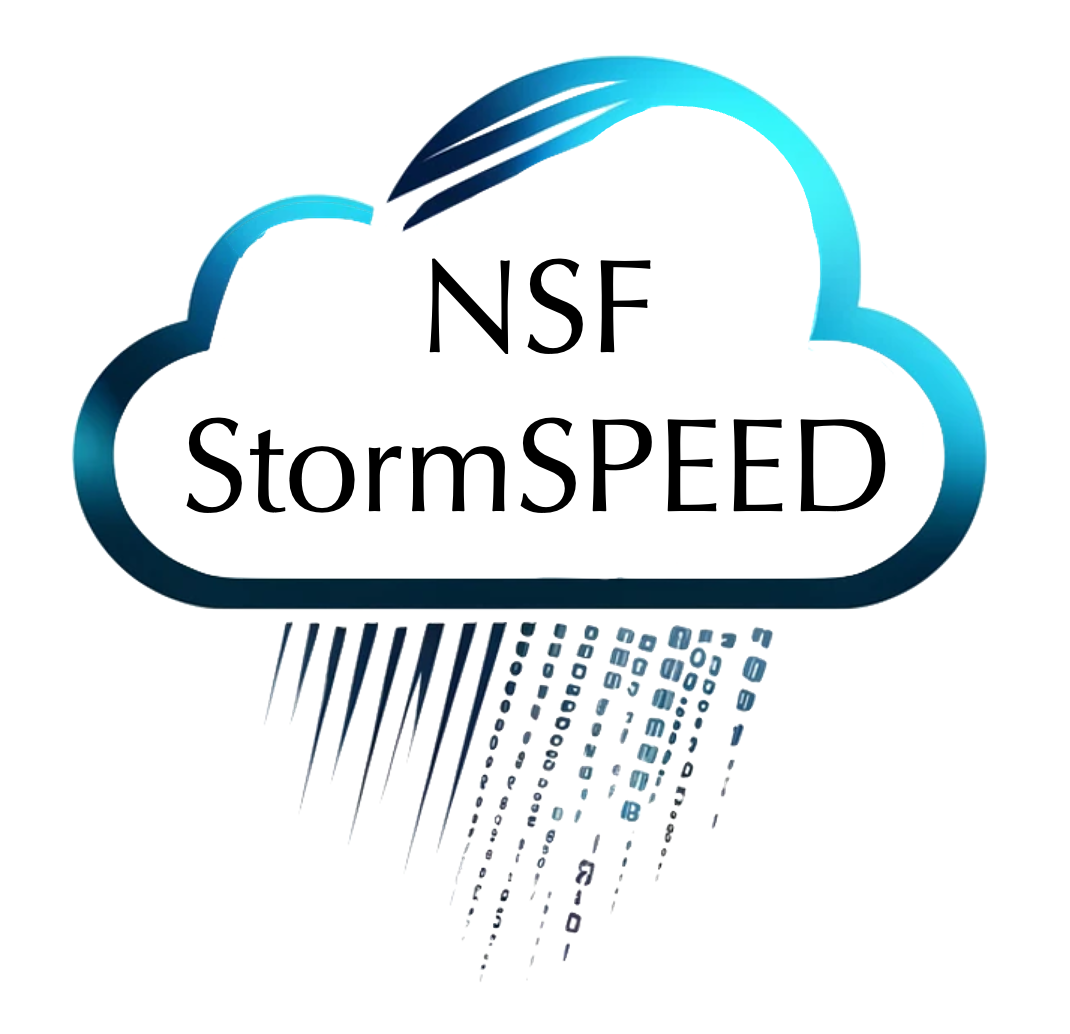
An exemplar of a high-resolution simulation with NCAR’s CESM model (25 km atmosphere and land grid, 10 km ocean grid) is shown below to highlight the capabilities of high- and ultra-high- (3 km) resolution models. The clip was generated by the NCAR-TAMU MESACLIP team which are project partners in StormSPEED. The clip shows a time lapse of the specific humidity, sea surface temperature and the precipitation rate over land for a future climate scenario in the year 2100.
Machine Learning Concepts for the Atmospheric Sciences
Machine learning approaches and new data science algorithms are an emerging frontier for the atmospheric sciences. We explore whether newly developed physics-aware machine learning algorithms trained with model data or observations can replace subgrid-scale physical parameterizations in forecast models, such as the time-consuming solar radiation code, or the shallow or deep convection cloud schemes. A second, less aggressive approach is to utilize machine learning approaches for the estimation of uncertain parameters in physical parameterizations. We use idealized GCM model configuration to intercompare the pros and cons of various machine learning algorithms, such as linear regression, random forests, boosted forests, artificial neural networks (ANN) and deep neural networks with and without convolutions. An example of a dry simulation with NCAR’s Community Atmosphere Model version 6 (CAM6) is presented below. The figure compares the model-generated temperature tendency to the temperature tendency that was generated via a neural network (NN) emulator. The NN reproduces the temperature tendency with high precision.

Reference: Limon, G. and C. Jablonowski (2019), An Assessment of Machine Learning Techniques for Replicating Physical Forcing Mechanisms in Climate Models, American Geophysical Union (AGU) Fall Meeting, Abstract A41R-2898, San Francisco, CA, USA, Dec. 9-13, 2019, available in the online archive: Earth and Space Science Open Archive, doi: 10.1002/essoar.10501799.1
We also investigate machine learning techniques, such as boosted forests (XGBoost) and Long Short-Term Memory (LSTM) Neural Networks, to predict the winter ice cover in the St. Marys River system with 7-day and 30-day lead times. The St. Marys River connects Lake Superior and Lake Huron in the Great Lakes region (see the figure below) and is an important waterway for the shipping community. See our webpage https://expglice.seas.umich.edu/ice-forecast/ for more information on the project and the research team.

Impact of the Mt. Pinatubo and Hunga-Tonga Volcanic Eruptions on the Atmospheric Circulation
Volcanic eruptions are well-known to affect the climate through multiple direct and indirect means that operate across a wide range of timescales. We work on two projects that focus on the climate impacts of the Mt. Pinatubo (1991) and the Hunga-Tonga (2022) volcanic eruptions. The latter was an underwater volcano that deposited sulfate dioxide and vast amounts of water vapor into the stratosphere. They impact the radiative balance and ozone chemistry in the stratosphere, as well as the dynamic flow response. We use both the Department of Energy (DoE) Energy Exascale Earth System Model (E3SM) and the NCAR Community Earth System Model (CESM) to conduct this research. This includes model enhancements of E3SM which we augmented with new passive and dynamic tracers such as the ‘Age-of-Air’ tracer. The E3SM work is also further described below (CLDERA project).
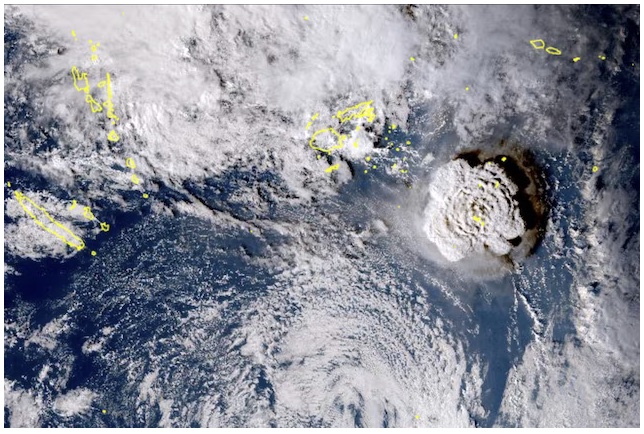
Detecting Pathways in Climate Models: Project CLDERA
CLDERA (CLimate impact: Determining Etiology thRough pAthways) is funded by the Department of Energy’s (DoE) Sandia National Laboratories (2021-2024). The goal is to enable climate attribution via DoE’s E3SM climate model for currently unachievable scenarios. This is accomplished via novel computational/statistical approaches to uncover and employ “pathways”, defined as the chain of physical processes between source and impacts and their spatio-temporal evolution. In particular, active and passive tracers, novel software profiling applications, machine learning tools, and tiered simulation/verification strategies are used. These modeling techniques are fused with large-scale observational data from the 1991 Mt. Pinatubo volcanic eruption to elucidate the dominant pathways between source and impacts. CLDERA is expected to be a transformative for climate statistical approaches and attribution research, and will inform national security and policy considerations of decision-makers. Our role is to contribute to CLDERA’s tiered verification via idealized E3SMv2 simulations of the Mt. Pinatubo volcanic eruption, augment E3SM with dynamic and passive tracers, such as potential vorticity, potential temperature, age of air (AOA), E90, and ST80, and assess the realism of E3SMv2’s stratospheric circulation. This includes phenomena such as the Quasi-Biennial Oscillation (QBO), the water vapor tape recorder, sudden stratospheric warmings (SSWs), and the general climatology. An example of the specific humidity climatology is shown below.

Great Lakes Weather Research with Coupled Atmosphere-Lake Models
The goal of this joint project between the University of Michigan (UM), NOAA’s Great Lakes Environmental Research Laboratory (GLERL), NWS/WFO Detroit, NOAA’s ESRL/Global Systems Laboratory (GSL) and NCEP/EMC is to improve lake-effect snow and ice forecasting capabilities via advanced lake-ice-atmosphere coupling techniques for the Unified Forecast System (UFS). UFS is NOAA’s newest multi-scale modeling framework. It contains the global UFS Medium-Range Weather (UFS-MRW) application, which integrates GFDL’s FV3 dynamical core with NOAA’s GFS physics packages, as well as the UFS Short-Range Weather application (UFS-SRW, also called Rapid Refresh Forecast System RRFS). The latter is an FV3-based limited-area model which supports various GSL physics options for convection-allowing model (CAM) simulations. A missing component in UFS are lake interactions that are crucially important for accurate forecasts of extreme winter-weather precipitation events in the Great Lakes region. The project addresses this gap by (a) advancing the operational status of NOAA’s 3D lake model FVCOM and its coupling to ice in FVCOM-CICE for the Great Lakes, (b) loosely coupling FVCOM and FVCOM-CICE to the UFS high-resolution weather prediction models with a particular focus on UFS-SRW, (c) working with NWS/WFO weather forecasters on objective evaluations of the coupling capabilities via the Hydrometeorology testbed (HMT) and the participation in the Winter Weather Experiment, and (d) transitioning the modeling and coupling advances to high readiness levels in preparation for their operational use. Therefore, this project fills critical gaps in coastal hydrodynamic forecasting and provide NWS/WFO operational forecasters with improved lake-effect snowfall, precipitation, visibility and ice forecasts to protect the safety of the citizens in the Great Lakes region.
Figure: Example of a stretched, variable-resolution grid configuration (called C768s5) of the global UFS weather prediction model, which provides high-resolution grid spacings of about 3 km over the Great Lakes Region (left, inner square). Right panel depicts the forecasted precipitation (here shown as the snow water equivalent SWE) which accumulated from January 27 to February 1, 2019. This shows the ability of the variable-resolution configuration of UFS-FV3GFS to create lake-effect snowfall downwind of the Great Lakes.
Scale Interactions: Impact of Meso-Scale Convective Systems (MCSs) on the Downstream Development of the Large-Scale Flow
North American Mesoscale Convective Systems (MCSs) have been linked to instances of poorly forecasted Rossby wave packets (RWPs) and forecast busts over Europe. In addition, MCSs have been observed in connection with regions of negative potential vorticity. This research project investigates the dynamical role of negative potential vorticity on the downstream evolution of jet streaks and Rossby waves in a variety of forecast models and reanalyses products such as ERA5 (see Lojko et al., 2022). In particular, we use model results from the European Centre for Medium-Range Weather Forecasting (ECMWF), Japanese Meteorological Agency (JMA), National Center for Environmental Protection (NCEP), and the Korean Meteorological Agency (KMA) that are stored within ‘The International Grand Global Ensemble’ (TIGGE) archive. In addition, we conduct variable-resolution experiments with NCAR’s Model for Prediction Across Scales (MPAS).
Figure: Frequency of negative potential vorticity from 2000 – 2021 based on ERA5 reanalyses data for the winter (DJF), spring (MAM), summer (JJA), and fall (SON) seasons. The data are filtered to focus on the occurences of negative PV near the tropopause jet stream (for details see the manuscript by Lojko et al., 2023).
High-Resolution, Variable-Resolution and Adaptive Mesh Refinement (AMR) Techniques for Atmospheric Simulations
The climate system is characterized by complex nonlinear interactions over a broad range of temporal and spatial scales. Our research objective is to determine how these multi-scales interact and how to use enabling computational tools to mathematically represent scale interactions in climate models. The research focuses in particular on scale interactions in the dynamical core of GCMs. The dynamical core refers to the fluid dynamics component of a GCM and encompasses the numerical methods used to solve the equations of motion on the resolved scales. The research, for example, explores how Adaptive Mesh Refinement (AMR) and static variable-resolution grid techniques allow high resolution meshes in regions of interest like the eye of a tropical cyclone or over mountainous terrain. It thereby suggests pathways how to bridge the scale discrepancies between local, regional and global phenomena, a key frontier in climate modeling.
The variable-resolution as well as uniform high-resolution approaches are focused on cubed-sphere computational meshes. Cubed-sphere grids offer an almost uniform grid point coverage on the sphere. They deliver high performance and almost perfect scaling characteristics on massively parallel computer architectures. The grid is ideally suited for local grid refinements that are, e.g., based on DoE’s AMR software framework Chombo from the Lawrence Berkeley National Laboratory (LBNL). Both hydrostatic and nonhydrostatic dynamical core designs are developed, implemented and assessed in our team using high-order conservative and oscillation-free finite-volume numerical schemes. In addition, we investigate the numerical schemes in a 2d shallow-water framework that serves as an ideal testbed for 3d model developments, and utilize the variable-resolution and high-resolution capabilities of the NCAR/DoE Spectral Element dynamical core as well as NCAR’s MPAS model.
Figure: Examples of the adaptive mesh refinement and variable-resolution techniques applied to (left) a block-structured Finite-Volume (FV) shallow water model on a latitude-longitude grid, (middle) the conformal cubed-sphere grid in NCAR’s Spectral Element (SE) model, and (right) the block-structured Chombo shallow water model on the cubed-sphere grid. The left figure shows how the refined regions track the relative vorticity fields of a barotropic instability in the model FV (see St-Cyr et al., 2008), the middle figure illustrates a static (non-moving) variable-resolution mesh in the model CAM-SE (see e.g. Zarzycki and Jablonowski, 2014, 2015), and the right figure depicts the vorticity field of two merging vortices after four days with the Chombo model (see Ferguson et al., 2016).
Community Outreach: The ‘Dynamical Core Model Intercomparison Project’ (DCMIP)
In 2008, 2012, and 2016 (likely again in 2025) we organized DCMIP summer schools and model intercomparison workshops with a special focus on the newest non-hydrostatic global model developments. In particular, we invited students, postdocs and the international dynamical core modeling community to join us at the National Center for Atmospheric Research (NCAR, Boulder, CO) for 2 weeks for several exciting, student-focused, and research-driven events that led to an unprecedented dynamical core intercomparison project. We utilize existing and newly designed idealized dynamical core test cases to assess the impact of the numerical schemes and the model designs on the fluid flow. This includes assessments of the physics-dynamics coupling aspects. DCMIP had been endorsed by the WMO Working Group on Numerical Experimentation (WGNE). A fuller description of the DCMIP events is available under the ‘Education’ tab.
We have published a book that is based on the lectures from the 2008 DCMIP Summer Colloquium:
Lauritzen, P. H., C. Jablonowski, M. A. Taylor and R. D. Nair (Eds.) (2011), Numerical Techniques for Global Atmospheric Models, Lecture Notes in Computational Science and Engineering, Springer, Vol. 80, 572 pp.
Numerical Methods and Advanced Equation Sets for the Dynamical Cores of GCMs: Towards Convection-Allowing and Whole-Atmosphere Climate Models
We develop, implement and test new numerical methods for the dynamical cores of atmospheric General Circulation Models (GCMs). We also investigate advanced equation sets, such as non-hydrostatic and ‘deep-atmosphere’ configurations, for dynamical cores with a particular focus on the DoE climate model E3SM and its Spectral Element (SE) dynamical core called HOMME. The SE dynamical core is currently also used in its hydrostatic version in NCAR’s CESM climate model. Over the 2024-2026 time frame, we will integrate DoE’s non-hydrostatic SE model into the CESM framework (funded by NSF), and will thereby enable community research at convection-allowing scales (down to kilometer-scale grid spacings) with CESM.
We also develop new numerical schemes for dynamical cores. An example of a new high-order finite-volume model development on a cubed-sphere grid is shown below. This project paid special attention to 3rd-order and 4th-order accurate finite-volume discretizations that perform well at all spatial scales and all aspect ratios between the horizontal and vertical resolution. Such methods are promising candidate for future non-hydrostatic dynamical cores with flexible computational grids. In 2012, we developed the non-hydrostatic dynamical core ‘MCore’ in both a Cartesian channel configuration (Ullrich and Jablonowski, 2012, Mon. Wea. Rev. ) and on a spherical cubed-sphere grid (Ullrich and Jablonowski, 2012, J. Comput. Phys.). More recently, we investigated Lagrangian particle techniques and adaptive mesh refinement techniques for spherical domains and utilize the barotropic vorticity and shallow water equations as idealized testbeds.

Dynamical Core Test Cases and Intercomparisons
The dynamical core of atmospheric GCMs respresents the fluid dynamics component of every climate and weather forecasting model. Tests of GCMs and, in particular, tests of their dynamical cores are important steps towards future model improvements. They reveal the influence of an individual model design on climate and weather simulations and indicate whether the circulation is described representatively by the numerical approach. However, testing a global 3D atmospheric model and it dynamical core is not straightforward. In the absence of non-trivial analytic solutions, the model evaluations most commonly rely on intuition, experience and model intercomparisons.
We develop idealized test cases for dynamical cores and conduct international Dynamical Core Model Intercomparison Projects (DCMIP) (e.g. at NCAR in June 2008, DCMIP-2012 in August 2012 and DCMIP-2016 in June 2016). An example of a dynamical core test is the evolution of a baroclinic wave that is also depicted in the figure below. In addition, we work on test cases with intermediate complexity that include simple moisture feedbacks, e.g. for tropical cyclone-like simulations. Our most recent test case investigates the response of the dynamical cores to topographic forcings (Hughes and Jablonowski, 2023).
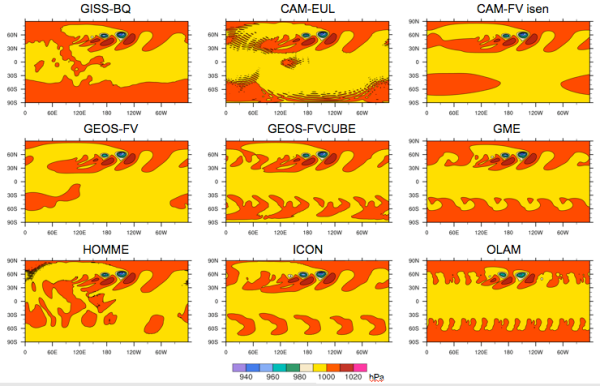
Subgrid-Scale Mixing in Climate Models: A Novel Look at Diffusion, Accuracy, Stability and Climate Sensitivity
It is important to assess and quantify the role of unresolved subgrid-scale mixing processes in the dynamical cores of state-of-the-art GCMs. The representation of the subgrid scale in GCMs is complex. Besides physical processes to be represented, numerical errors manifest themselves as subgrid-scale diffusion, and mixing is used to assure numerical stability and to compensate for numerical dispersion errors. The quantitative effect of physical mixing is therefore conflated with mixing processes associated with filtering, implicit and explicit diffusion and numerical errors. This raises new questions concerning the accuracy, stability and climate sensitivity of today’s climate modeling approaches.
We focus our research on the numerical schemes used in NCAR’s Community Atmosphere Model version 5 (CAM 5 and version 6 (CAM6). These two model configurations have options for several, very different dynamical cores. These are the spectral-transform Eulerian and semi-Lagrangian dynamical cores, the GFDL’s Finite Volume dynamical core on a latitude-longitude grid (FV) and the cubed-sphere grid (FV3), the spectral element (SE) dynamics package as well as MPAS. All dynamical cores are well established and propagate resolved, long-scale, structures with credible accuracy. However, they all treat small-scales differently, from the point of view of both physical processes and numerical construction. In our research we perform a set of numerical experiments with increasing complexity. In particular, we analyze the subgrid-scale characteristics of idealized dynamical core experiments like baroclinic instability studies, perform long-term Held-Suarez climate runs with idealized forcing functions and assess aqua-planet simulations with intermediate complexity. In addition, the subgrid-scale mixing in tracer transport experiments is investigated. We develop and apply evaluation techniques and test whether the lessons learned in simplified experiments are predictors of the performance in climate models. In 2011, we published a 113-page Springer book chapter on the pros and cons of diffusion, filters and fixers in GCMs that sheds light on the many subgrid-scale mechanisms in today’s weather and climate models.

Tropical Cyclones in General Circulation Models
This project investigates and improves the representation of tropical cyclones in the National Center for Atmospheric Research (NCAR) Community Earth System Model CESM. CESM is jointly supported by the Department of Energy (DOE) and the National Science Foundation and contains the Community Atmosphere Model CAM that offers multiple dynamical cores and physics options. In particular, CAM version 5 contains the finite-volume (FV) dynamical core, the spectral element (SE) dynamical core, and the spectral transform Eulerian (EUL) and semi-Lagriangian (SLD) dynamical cores. The most recent CESM version 2.2 with its CAM 6 atmosphere model provides access to GFDL’s cubed-sphere finite-volume dynamical core FV3 and the dynamical core of the Mpdel for Prediction Across Scales (MPAS).
The objectives of the research are to (1) simulate the evolution of an idealized, initially weak vortex into a tropical cyclone in an aqua-planet configuration of CAM, (2) investigate the sensitivity of tropical cyclone development and structure to varying resolutions and convective parameterizations within CAM, (3) explore the impact of different numerical schemes on the evolution of tropical cyclones through utilization of numerous dynamical cores available in CAM, and (4) use the knowledge gained from these simulations to project the possible effects of climate change on long-term (decadal) tropical cyclone statistics. Such process studies will reveal the impact and relative importance of the physical parameterizations and numerical schemes on the simulations of tropical cyclones in CAM, thereby providing an improved scientific basis for the projections of tropical cyclone activity under changing climate conditions.
We have developed an idealized tropical cyclone test case based on analytic initial conditions that spins up intense (up to category-5) tropical cyclones over the course of 5-10 simulation days. We have also developed a simplified physics package called ‘simple physics’ for aqua-planet studies that only contains the most basic driving mechanisms for cyclones such as surface fluxes, boundary layer diffusion and large-scale condensation. This physics package lets us define a test case of intermediate complexity.

Stratospheric Dynamics: The Quasi-Biennial Oscillation (QBO), Sudden Stratospheric Warmings (SSWs), Tape Recorder, and the Brewer-Dobson Circulation
We assess the characteristics of the QBO, SSWs, the water vapor tape recorder, and the Brewer-Dobson circulation in both complex and idealized climate models, such as DoE’s E3SM or NCAR’s Community Atmosphere Model (CAM). The QBO is a phenomenon that takes place in the equatorial stratosphere where the zonal wind oscillates between the westward and eastward phase with a period of about 28 months. The tape recorder marks the upward and seasonally-varying transport of water vapor in the tropical stratosphere, SSWs are occasional collapses of the westerly polar jet in the polar stratosphere, and the Brewer-Dobson circulation describes the transport of tracers in the stratosphere. Many phenomena in the stratosphere are wave-driven and excellent examples of wave-mean flow interactions. The QBO is believed to be driven by gravity waves and equatorially trapped vertically propagating waves, in particular Kelvin and Mixed Rossby-Gravity waves, which act as momentum sources. In nature, these waves are e.g. triggered by tropical convection. SSWs are driven by upward propagating long Rossby waves (with wavenumber 1 or 2) which originate in the tropospheric midlatitudes.
In order to analyze the QBO behavior and the phenomena that contribute to its forcing we e.g. use the Transformed Eularian Mean (TEM) analysis as well as wavenumber-frequency assessments (Wheeler-Kiladis). Wavenumber-frequency diagrams reveal if certain wave types are present in the data, such as Kelvin or mixed Rossby-Gravity waves. Kelvin waves are expected to have periods of about 15 days, with zonal wavenumber of about 1-2, and usually observed when the mean zonal flow is easterly. Mixed Rossby-Gravity waves are expected to have a 4-5-day period, with a zonal wavenumber of around 4. They are usually observed when the mean zonal flow is westerly. The figure below illustrates such analyses for the tropical region, derived from an idealized CAM model simulation with the semi-Langrian spectral transform dynamical core. We also apply our analysis technique to Sudden Stratospheric Warming (SSW) events to shed light on the interplay between waves and the mean flow, and investigate the impact of gravity wave drag parameterizations on the dynamics-physics interaction. These analyses reveal what the impact of the numerical dynamical core design is on the modeled stratospheric circulation.
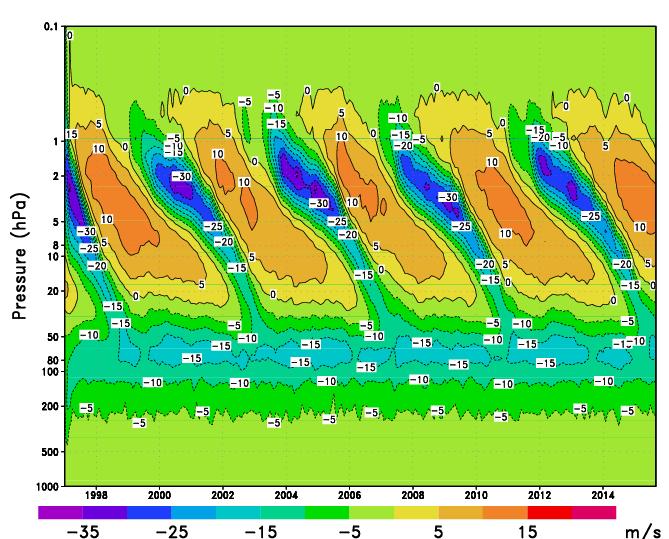
Updated on Aug/15/2024


